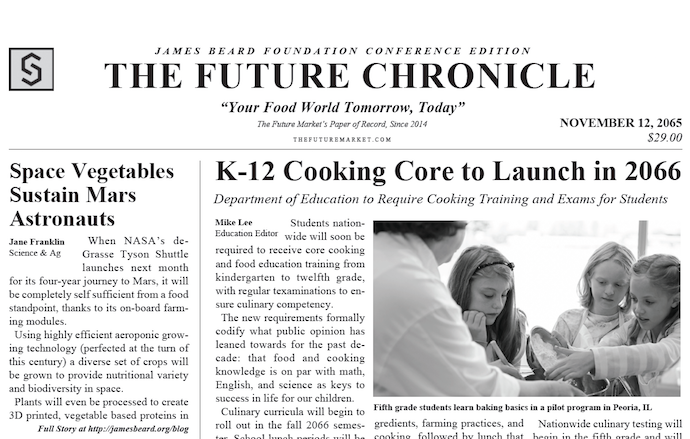The Future Chroncile, Part 2: Spacecraft Farming on the 2066 Mars Mission
Mike Lee
Mike LeeNovember 19, 2015

As we wrap up our coverage of the 2015 JBF Food Conference, we turn our eyes to the possibilities of tomorrow's farms, restaurants, grocery stores, and kitchens. We've partnered with the Future Market for a multi-part series exploring some of the visions of the future discussed at the conference, in the form of the Future Chronicle, a newspaper snapshot of 2065. Read the full issue here, and stay tuned for more dispatches from the mid-twenty-first century.
Mars Mission Supported by Spacecraft Farming System
Mike Lee
Science Editor
When NASA’s deGrasse Tyson Shuttle launches next month for its four-year journey to Mars, it will be completely self-sufficient from a food standpoint, thanks to its on-board farming modules and 3D food printers. Using highly efficient aeroponic agricultural technology (perfected at the turn of this century) a diverse set of crops will be grown to provide nutritional variety and biodiversity in space.
Aeroponics are an ideal choice to address the resource constraints of the shuttle mission, as the amount of calories generated per liter of water and watt-hour of electricity far outpace any other form of non-soil farming. Farming modules are comprised of focused spectrum LED lights and aeroponic misters that spray a precise blend of nutrients onto crop roots. The highly efficient system has accelerated crop cycles to 1 to 2 days, versus the 12 to 16 day crop cycles averaged during the early days of this technology’s development at the beginning of the twenty-first century.
Plants can also be processed into protein substitutes for use in the ship’s on-board 3D food printer. Aeroponic greens, grains, and seeds are processed into a protein slurry that is loaded into the printer and programmed to fabricate plant-based “meat” that mimics beef, pork, or chicken.
The 3D food printer is pre-programmed with over 15,000 recipes, many of them inspired by the preferences of the crew. During mission simulations on Earth, these recipes made a big impact on morale. Lieutenant commander Jane Blackburn said, “when I’m 140 million miles away from home, it’s comforting to know that I can end my day by printing up a copy of mom’s chicken pot pie.”
When astronauts faced a battery of stress tests in simulation, most of them scored markedly better after consuming meals that had an element of nostalgia and comfort to them. “The growing system makes sure we get all the core nutrients we need, but the 3D food printer supplies the emotional boost. It’s much easier to function so far away from Earth when you can have a piece of home on your plate and on-demand,” noted Blackburn.
NASA has also built stool sample sensors into the ship’s sewage system to continuously analyze each astronaut’s microbiome via their fecal matter. This data is linked to the aeroponic and 3D food printing systems to automatically adjust the kinds of nutrients that each crewmember needs. Mission leader Henry Smith commented, “so many things could go wrong on this mission and we want to ensure that our astronauts are getting exactly the food they need and nothing they don’t.”
--
Read the first dispatch from the Future Chronicle here.
The Future Chronicle is the official paper of record for the Future Market. See what's on the shelves of the Future Market here.






